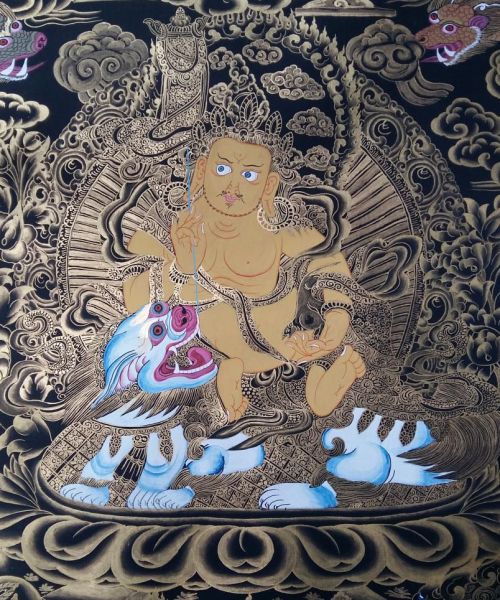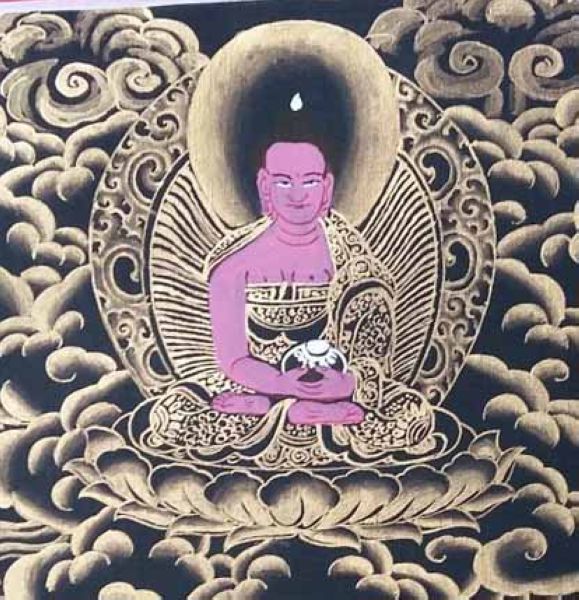Description
Dzambhala Thangka is hand-painted in Cotton Canvas in Kathmandu, Nepal. In Hindushim, it is also called Kubera. It is painted Jambhala Thangka is the god of prosperity in Buddhism and helps to eradicate poverty.
Dzambala is depicted in the center of the thangka. It is pronounced like Yellow Jambhala. Manjushree is presented at the left down of the Dzambhala Thangka in the thangka. Vajrapani is presented at the right down of the Dzambhala Thangka in the thangka. Amitabha Buddha is presented at the top of the Dzambhala Thangka in thangka.
Iconography of Dzambala
Dzambala is considered the most popular and powerful Wealth of God. He is the emanation of Buddha Ratnasambhava. He can remove poverty within the six realms, increasing virtues, life span, and wisdom.
He is also said to be an emanation of Vaisravana, one of the “Four Great World-protecting Heavenly Kings”. He is the guardian of light in Buddhism, a great charitable deity who grants fortune and protection. Lord Vaisravana lives in the northern region under the Four Heavens, at the northern crystal palace on the fourth level of Mount Sumeru.
According to the commentary on Lotus Sutra, this heavenly king is extremely knowledgeable as his perpetual protection of the Buddhas has enabled him to receive many teachings. Yellow Jambhala has a yellow-colored body, he sits in the vajra position with his right leg panhandled, his right foot is above a snail and lotus flower, and his left leg is kinked. He has one face and two arms. His left hand holds a mongoose named Nehulay which spews forth precious jewels from its mouth, while his right-hand holds gems-shaped fruit and the leaf of a lotus.
An ordinary image of Lord Vaisravana is one that holds a precious pagoda on the left, which pours out various treasures. In Tibetan Tantric images, the precious pagoda is replaced by the treasure-emitting mongoose. Yellow Jambhala sits on a lotus, sun disk, and moon disk.
Mantra of Dzambala
The mantra of Dzambala is Om Jambhala Jalendraye Svaha.
Iconography of Manjushree
Manjushree is presented at the left down of the Dzambhala Thangka in the thangka. Manjushree is the Bodhisattva who holds the flaming sword of enlightenment, by his left hand in a warning hand gesture in the left hand representing his realization of wisdom to cut through ignorance & wrong view. His right hand depicted in teaching holds the stem of a Blue Lotus flower upon which rests the Book (Pustaka) of Perfection of Transcendental Wisdom.
Mantra of Manjushree
The mantra of Manjushree is Om A Ra Pa Ca Na Dhih.
Iconography of Vajrapani
Vajrapani is presented at the right down of the Dzambhala Thangka in the thangka. Vajrapaṇi is one of the earliest bodhisattvas of Mahayana Buddhism. He is the protector and guide of the Buddha and rose to symbolize the Buddha’s power.
Vajrapani is pictured dancing wildly within a halo of flames which represents transformation. He holds a vajra (thunderbolt) in his right hand which emphasizes the power to cut through the darkness of delusion. Vajrapani looks wrathful, but as a representation of the enlightened mind. He is completely free from hatred.
Mantra of Vajrapani
The mantra of Vajrapani is om vajrapani hum phat.
Iconography of Amitabha buddha
Amitabha Buddha is presented at the top of the Dzambhala Thangkain thangka. Amitabha is head of the Lotus Family, one of the oldest & significant of the Five Buddha Families. This family represents love, purity, compassion & peace. Amitabha Purelandis a place of infinite bliss & boundless light.
Amitabha Buddha is also one of the five Tathagatas representing the wisdoAmitabha Buddha is also one of the five Tathagatas representing the wisdom of discriminating awareness. Amitabha Buddha is red in color. He is represented in the stupa facing to the west. He rides on a peacock symbolizing that he can take away the suffering of others just as the peacock eats poisonous plants and yet his tail shines forth.
Mantra of Amitabha Buddha
The mantra of Amitabha Buddha is Om ami dewa hr.

































Reviews
There are no reviews yet.